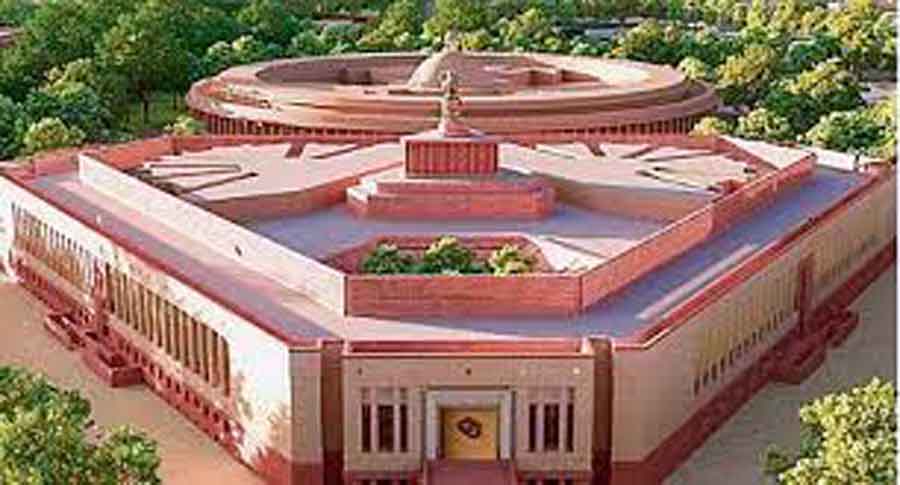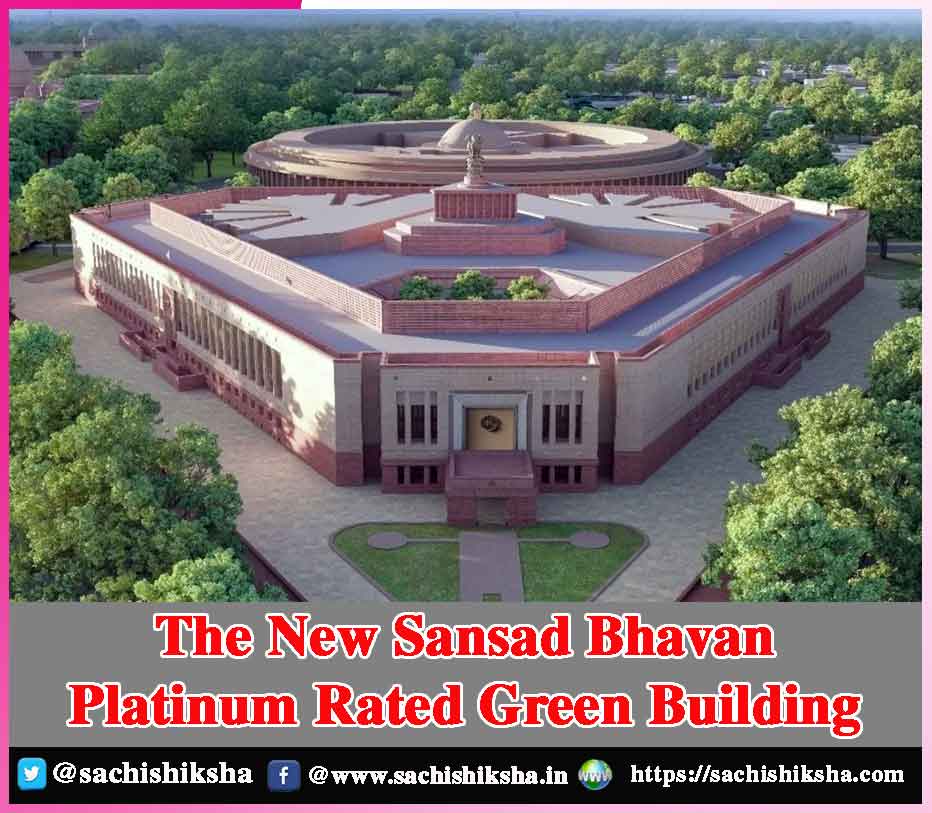The New Sansad Bhavan –Platinum Rated Green Building
Introduction:
From its inauguration in 1927, the Indian Parliament has served as an emblem of republican authority. The elliptical framework, situated in the middle of New Delhi, was built by British designers Sir Edwin Lutyens and Sir Herbert Baker to encapsulate the basic principles of Indo-Saracenic architecture.
In the past few years, the government has embarked on a massive reconstruction initiative to breathe new life into the historic building and guarantee it serves the developing requirements of a democratic society. The renovation plan prioritizes increasing the Parliament Building’s capability, usefulness, and availability while maintaining its historical legacy and appearance.
Also Read :-
- Schools Being Opened
- Education and Women
- Career Options & Choices
- Top Makeup trends for Teenagers
- Online Classes Bane or Boon?
Table of Contents
Remarkable Accomplishment:

Symbol of India’s Dedication to Sovereignty:
The newly constructed building embodies India’s dedication to sovereignty and environmental responsibility, featuring greater capacity for seating, innovative technology, and an intersection of modernism and traditional history. It features excellent works of art, sustainable construction practices, and broad accessibility. This magnificent masterpiece heralds the beginning of an entirely fresh phase in India’s parliamentary history.
Seating Capacity:
As compared to the earlier complex, the massive triangular structure contains both the governing houses of Lok Sabha and Rajya Sabha, with a significantly larger seating area. The new Lok Sabha chamber has three times the amount of seats, with sufficient space for 888 individuals, and the new Rajya Sabha has room for 248 members. This is because the subsequent separation exercise may result in a boost in the total amount of MPs in the entire nation.
Modern Amenities:
The new building has been fitted with modern amenities, and honours India’s legacy by drawing architectural inspiration from prominent ancient structures such as the Rashtrapati Bhavan.
Representation of Indian Society:
The building incorporates several features that represent Indian society: the Lok Sabha is founded on a peacock theme, whereas the Rajya Sabha looks like a lotus, India’s national flower. The structures have a courtyard that opens with a Banyan tree, India’s national tree, which adds to the cultural feel of the structure.
Sengol- A Landmark of Indian Convention:
The installation of Sengol in the Lok Sabha is perhaps the most prominent landmark of Indian convention, albeit there is presently a debate regarding the government’s assertions. The sceptre has been welcomed as a representation of the passing of authority from the British to Indians by the Government.
Ecological Sustainability:
Comprehensive conservation efforts at such a large and significant construction as the New Parliament House have resulted in improved air quality (within the construction site) – undoubtedly demonstrates how to move ahead for the whole building and infrastructure industry. It should be noted that these environmentally conscious options safeguard not only the natural environment but also employees and citizens who live nearby.
As a result, sustainable construction is a distinct prospect. India requires infrastructures with regard to its standard and quantity; consequently, the emphasis should be on introducing aggressive environmentally friendly practices such as those undertaken at the Modern Parliament Complex. The new Sansad Bhavan, a Platinum-rated environmentally friendly structure, is intended to serve as an emblem of India’s dedication to ecological sustainability.
Environmental Preservation:
The building harmoniously blends with the environmental setting, producing a tranquil and visually pleasant ambience, thanks to well designed vegetation and green areas. Integrating lush gardens, plantings of trees, and biodiversity-promoting elements improves the environment and demonstrates a dedication to environmental preservation. The structure employs green building methods and supplies. With its energy-saving and water-harvesting features, the Parliament’s newly constructed building is intended to be environmentally friendly.
Earthquake-resistant Structure:
Recognizing Delhi’s seismic susceptibility, the Parliament’s newly constructed building has been designed to be earthquake-resistant. It satisfies strict requirements for protecting people during earthquake incidents.
Indian Material:
Building supplies acquired from around India were utilized in the inside and outside of the modern structure. The granite stone came from Lakha hamlet in Jaisalmer, and the sandstone came from Sarmathura in Dholpur in Rajasthan.
Vaastu Shastra:
Vaastu Shastra, an old Indian architectural convention, is used in the construction of the Parliament building. Sentinel monuments of auspicious animals, such as elephants, horses, eagles, and swans, are displayed at all doorways because of their importance in Indian culture and Vaastu Shastra. Legendary animals like as the shardula and Makara are also depicted, lending the style of architecture a sense of mystic and meaning.
Abundant Lighting:
The new Parliament structure is environmentally friendly and long-lasting. Natural ventilation and lighting are abundant in the construction, reducing the requirement for synthetic lighting and air conditioning. Around the structure, technologies such as LED lighting and efficient HVAC systems are used. Furthermore, sources of renewable energy such as sunlight from panels produce renewable energy that may be utilized for electricity on the building’s infrastructure.
Wooden Design:
The wooden design of the architecture utilizes Nagpur wood, and ancient hand-knotted tapestries from Bhadohi artisans in Uttar Pradesh add to the elegance of the structure.
Technical Progress:
The new Parliament House welcomes digitization by transforming every document, particularly House sessions, inquiries and other activities. Tablets and iPads have been incorporated into the operation of the Parliament, enhancing effectiveness and knowledge availability.
Long Lasting:
The new structure, which was constructed utilizing environmentally friendly building techniques, is expected to lower electricity use by 30% in comparison to the old one. Harvesting of rainwater and methods for recycling are provided. According to the Ministry of Housing and Urban Affairs, it was built to be larger and more effective and to last for the 150 years that follow.
Built-up Area of 65000 Square Meters:
The new Parliament establishing, which will stand beside the present one, will have a built-up area of around 65,000 square meters. Its triangle design maximizes area utilization while adapting to the shifting requirements of a rising population.
Three Galleries:
The public portals take you to three galleries: the Sangeet Gallery, which displays Indian performing music, and melodic practices; the Sthapthya Gallery, which represents the nation’s architecture heritage; and the Shilp Gallery, which displays various handicraft practices from different parts of the country.
Conclusion:
The new Indian Parliament building is not only an emblem of representative administration, but additionally of the country’s dedication to sustainable architecture and responsibility for the environment. With its distinguishing characteristics, architectural philosophy, and environmentally conscious measures, this historic marvel exemplifies the seamless combination of tradition, and sustainability.
From its triangle design and earthquake-safe construction to the Lok Sabha and Rajya Sabha areas ornamented with meaningful themes, every feature of the building symbolizes India’s rich historical past. Bringing together resources from throughout the country and embracing technology advances emphasise the country’s unity and progress. Furthermore, the focus on energy conservation, environmental responsibility underlines India’s commitment to responsible environmental management and the creation of a place for everybody.












































